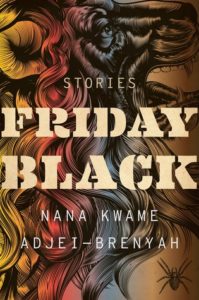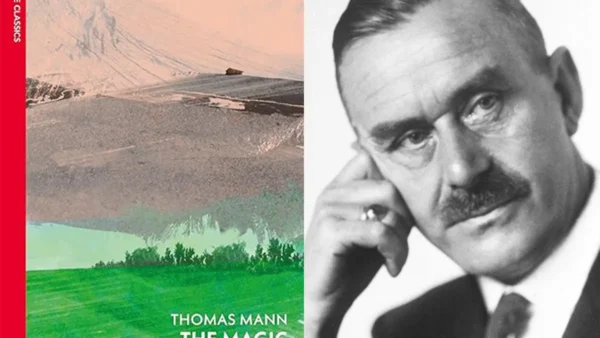Race and capitalism in America should be fertile ground for literary fiction. This year’s Black Friday shopping frenzy brought the usual bout of stabbings and shootings to add to the overall death count, not to mention the looming environmental collapse that such consumerism feeds. And the list of things you can’t do while black without having the police called or a gun pulled on you seems to expand by the day, from working out to moving into an apartment to buying Mentos.
Yet Friday Black by Nana Kwame Adjei-Brenyah startled me by the freshness, directness and urgency with which it dealt with these issues. In this debut collection of short stories, we meet zombie-like shoppers fighting over cut-price jackets, a theme park where visitors can experience the thrill of shooting a black intruder, a white homeowner who decapitates five black children with a chainsaw because he felt threatened.
If the setups sound extreme, that’s because they are. The realities of race and capitalism in America are extreme, so the satirist has to up his game to stay a step ahead. Yet the impressive achievement of Nana Kwame Adjei-Brenyah is to make them believable, to make sharp political points without coming over as didactic. That’s what the best political fiction does, and that’s what the stories in Friday Black deliver.
As the author told Vox in an interview:
“I turned up the volume because it’s interesting to think about how bad the violence has to be for us to care. I got to make more acute points about how readily we allow love to become conflated with things in the stores, things that are purchasable; how often we allow love to be externalized, turned into something we can buy back from whatever company. Exaggeration helps with that.”
I was hooked from the opening of the very first story, where we meet the main character, Emmanuel, consciously dialling his Blackness up and down on a 10-point scale as he tries to navigate life as a black man in America while being haunted by visions of a headless girl (one of the victims of the scared white man with the chainsaw) “waiting for him to do something, anything.”
Throughout the story, Emmanuel is pulled back and forth between bringing his Blackness down below 5 for his own safety and ratcheting it up towards 10 in solidarity with the Finkelstein Five and the movement inspired by their murder and the acquittal of their killer.
As his Blackness creeps up past 7.0, he remembers the advice of his father:
“‘You gotta know how to move,’ his father had said to him at a very young age. Emmanuel started learning the basics of his Blackness before he knew how to do long division: smiling when angry, whispering when he wanted to yell.”
There’s a palpable tension throughout the story between these learnt survival techniques and the anger he feels, the growing sense of obligation. How bad do things have to get before you do something, before you abandon the attempt to survive and try to change things, or at least to be more honest?
Characters face similar dilemmas in other stories. Zay needs a job, but is it worth playing the role of thug and getting beaten and shot multiple times a day by white patrons playing the role of indignant homeowner in a theme park? The retail workers in the stories dealing with mall life also have tough choices to make. They may not want to sell jackets to crazed sale shoppers, but they need work, and they just want to get through it without ending up like Lucy, the Taco Town cashier who jumped from the fourth floor on her lunch break.
Friday Black has received a lot of praise from the likes of George Saunders (“an excitement and a wonder”) and Roxane Gay (“dark and captivating and essential”), along with ecstatic write-ups in the major papers. Normally, when books get this much hype, the reality tends to disappoint me (c.f. The Flamethrowers, The Brief Wondrous Life of Oscar Wao). But this time, the book actually lived up to the hype. It’s one of the best books I’ve read in a long while, and if I were talking to you in person I’d press my copy into your hands and urge you to read it (which would be odd since it’s on my Kindle).
There are magical elements in some of the stories, sci-fi elements in others, and straight-up weirder-than-sci-fi reality in others. If you’re looking for something fresh and different and contemporary and beautifully written, do give it a try.





There are 6 comments
Super review Andrew. This book sounds so good. I just finished Black Skin, White Masks by Frantz Fannon. It sounds like some of the characters expressions of Blackmess in this book are similar to the philosophical points of Fannon’s book.
Ah, that’s an interesting comparison, Brian. I haven’t read that book, although I’ve always meant to. I’ll be interested to read your review of it!
I have been avoiding your post until I finished reading the collection myself and also finished my short coverage of it (which I’ll save for my short story roundup on the spring equinox, although I’m tempted to go back and add a link to the Vox interview you’ve called out – and I might yet).
One of the things I kept circling back to as I moved through the stories was that the collection might appeal to readers who are not usually willing to read short stories. There are more links between tales than many collections offer and, also, his tone is immediately engaging. And they’re quite plotty, so you really do want to see what happens (or you want to quantify the body count)! Did you have a favourite story? I’m not sure that I did (rather I think I just enjoyed his approach,the blend of political daring and literary playfulness) but I always enjoy stories with a retail setting, because I worked in stores for a long time and found the culture (such as it is) so curious.
That’s a good point about the appeal to people who don’t usually read short stories. There were definite connections between them, especially the retail stories with things like that prize jacket. I enjoyed the retail stories too, but I think my favourite was the very first one, with its deliberately extreme, unbelievable, exaggerated plot. It made me think about how things in the real world often seem extreme and exaggerated and unbelievable, especially around race in America. And, as I mentioned in the post, I loved that image of Emmanuel dialling his Blackness up and down to negotiate the white world. I look forward to reading your coverage!
By the time I read the first story, I’d already heard about that image in the NYT podcast, which I think released some of its intensity for me as a reader, but, even so, I still found it a powerful way to describe the process. And I can imagine, if I’d come to that story without any initial expectations, it would have seemed seeringly insightful.
Ah yes, I can see that it would lose some of its intensity from being discussed in a podcast first. For me, it just hit me as such a simple but apt way of describing the process. It was one of those moments that made me sit back as a reader and think, “Ah, OK, I’m in good hands.”